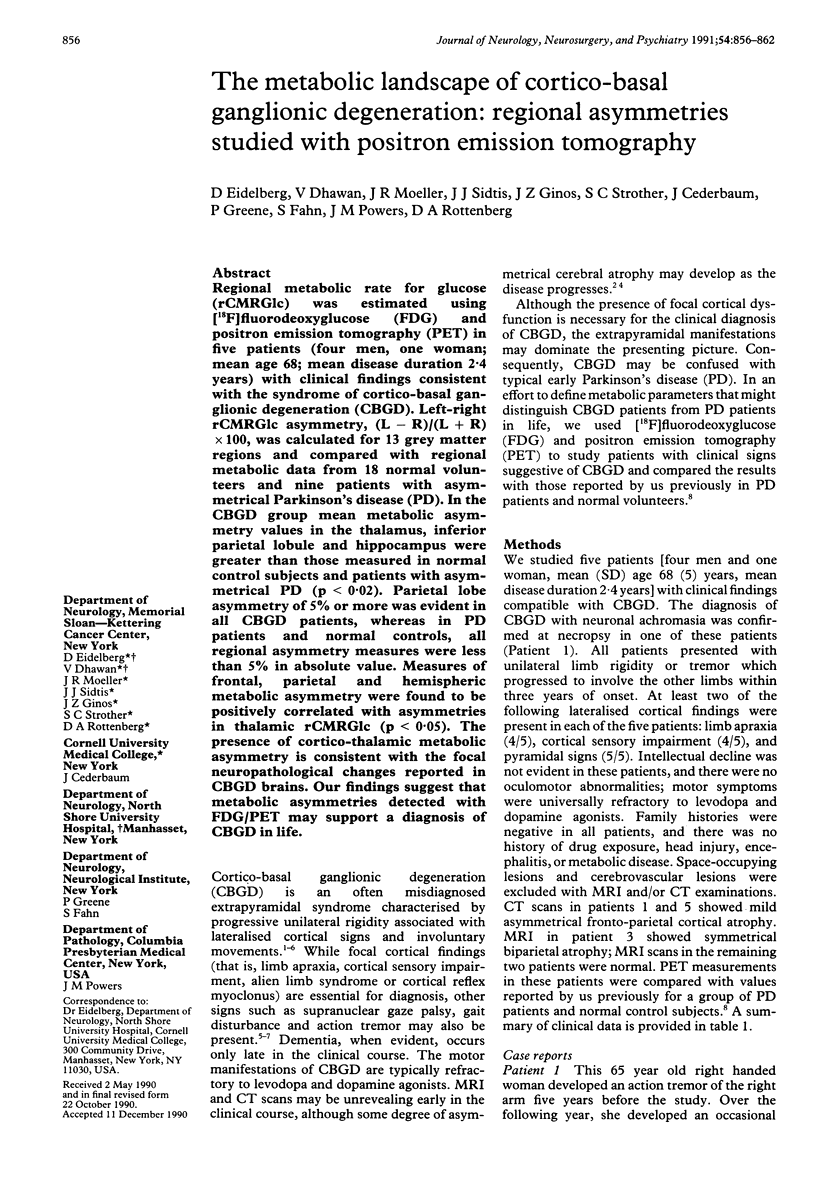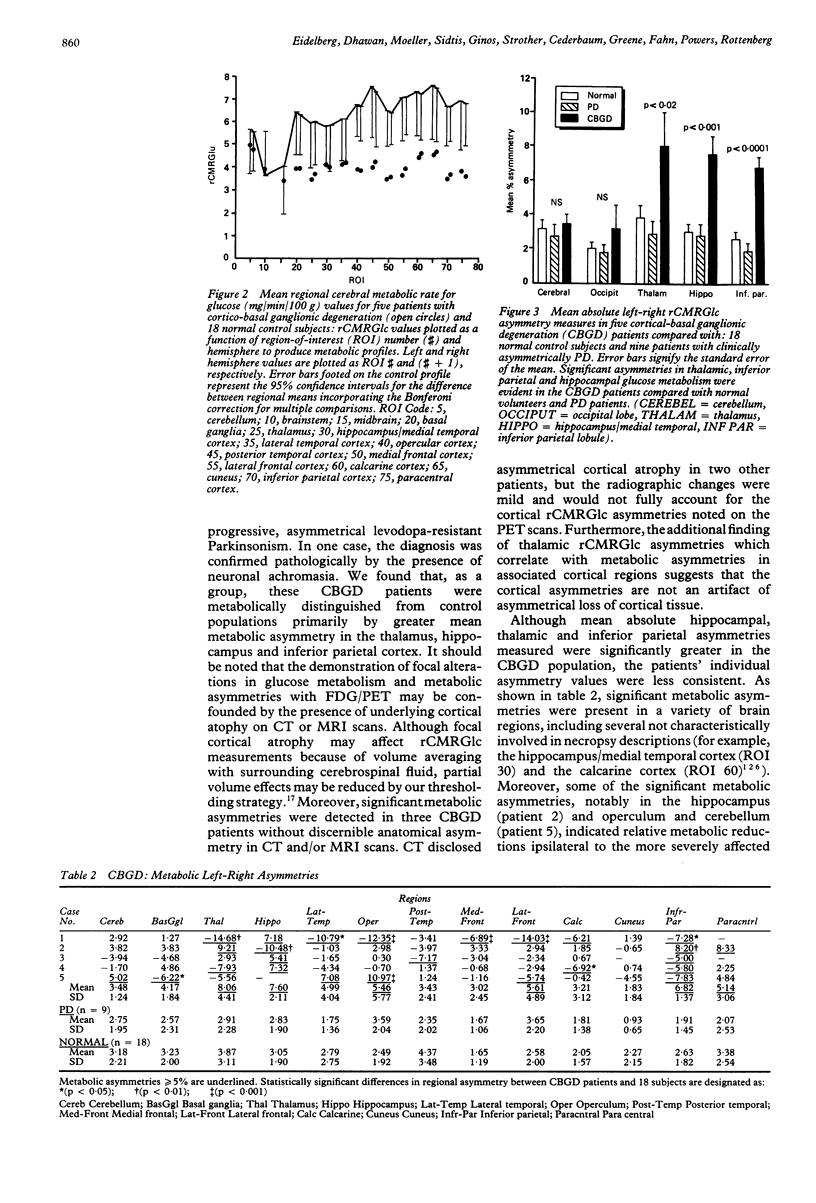Abstract
Regional metabolic rate for glucose (rCMRGlc) was estimated using [18F]fluorodeoxyglucose (FDG) and positron emission tomography (PET) in five patients (four men, one woman; mean age 68; mean disease duration 2.4 years) with clinical findings consistent with the syndrome of cortico-basal ganglionic degeneration (CBGD). Left-right rCMRGlc asymmetry, (L-R)/(L + R) x 100, was calculated for 13 grey matter regions and compared with regional metabolic data from 18 normal volunteers and nine patients with asymmetrical Parkinson's disease (PD). In the CBGD group mean metabolic asymmetry values in the thalamus, inferior parietal lobule and hippocampus were greater than those measured in normal control subjects and patients with asymmetrical PD (p less than 0.02). Parietal lobe asymmetry of 5% or more was evident in all CBGD patients, whereas in PD patients and normal controls, all regional asymmetry measures were less than 5% in absolute value. Measures of frontal, parietal and hemispheric metabolic asymmetry were found to be positively correlated with asymmetries in thalamic rCMRGlc (p less than 0.05). The presence of cortico-thalamic metabolic asymmetry is consistent with the focal neuropathological changes reported in CBGD brains. Our findings suggest that metabolic asymmetries detected with FDG/PET may support a diagnosis of CBGD in life.
Full text
PDF






Images in this article
Selected References
These references are in PubMed. This may not be the complete list of references from this article.
- Akiyama H., Harrop R., McGeer P. L., Peppard R., McGeer E. G. Crossed cerebellar and uncrossed basal ganglia and thalamic diaschisis in Alzheimer's disease. Neurology. 1989 Apr;39(4):541–548. doi: 10.1212/wnl.39.4.541. [DOI] [PubMed] [Google Scholar]
- Creasey H., Rapoport S. I. The aging human brain. Ann Neurol. 1985 Jan;17(1):2–10. doi: 10.1002/ana.410170103. [DOI] [PubMed] [Google Scholar]
- De Volder A. G., Francart J., Laterre C., Dooms G., Bol A., Michel C., Goffinet A. M. Decreased glucose utilization in the striatum and frontal lobe in probable striatonigral degeneration. Ann Neurol. 1989 Aug;26(2):239–247. doi: 10.1002/ana.410260210. [DOI] [PubMed] [Google Scholar]
- Dhawan V., Moeller J. R., Strother S. C., Evans A. C., Rottenberg D. A. Effect of selecting a fixed dephosphorylation rate on the estimation of rate constants and rCMRGlu from dynamic [18F] fluorodeoxyglucose/PET data. J Nucl Med. 1989 Sep;30(9):1483–1488. [PubMed] [Google Scholar]
- Douglass A. B., Harris L., Pazderka F. Monozygotic twins concordant for the narcoleptic syndrome. Neurology. 1989 Jan;39(1):140–141. doi: 10.1212/wnl.39.1.140. [DOI] [PubMed] [Google Scholar]
- Douglass A. B., Harris L., Pazderka F. Monozygotic twins concordant for the narcoleptic syndrome. Neurology. 1989 Jan;39(1):140–141. doi: 10.1212/wnl.39.1.140. [DOI] [PubMed] [Google Scholar]
- Eidelberg D., Galaburda A. M. Inferior parietal lobule. Divergent architectonic asymmetries in the human brain. Arch Neurol. 1984 Aug;41(8):843–852. doi: 10.1001/archneur.1984.04050190049013. [DOI] [PubMed] [Google Scholar]
- Eidelberg D., Galaburda A. M. Symmetry and asymmetry in the human posterior thalamus. I. Cytoarchitectonic analysis in normal persons. Arch Neurol. 1982 Jun;39(6):325–332. doi: 10.1001/archneur.1982.00510180003001. [DOI] [PubMed] [Google Scholar]
- Eidelberg D., Moeller J. R., Dhawan V., Sidtis J. J., Ginos J. Z., Strother S. C., Cedarbaum J., Greene P., Fahn S., Rottenberg D. A. The metabolic anatomy of Parkinson's disease: complementary [18F]fluorodeoxyglucose and [18F]fluorodopa positron emission tomographic studies. Mov Disord. 1990;5(3):203–213. doi: 10.1002/mds.870050304. [DOI] [PubMed] [Google Scholar]
- Evans A. C., Diksic M., Yamamoto Y. L., Kato A., Dagher A., Redies C., Hakim A. Effect of vascular activity in the determination of rate constants for the uptake of 18F-labeled 2-fluoro-2-deoxy-D-glucose: error analysis and normal values in older subjects. J Cereb Blood Flow Metab. 1986 Dec;6(6):724–738. doi: 10.1038/jcbfm.1986.129. [DOI] [PubMed] [Google Scholar]
- Foster N. L., Gilman S., Berent S., Morin E. M., Brown M. B., Koeppe R. A. Cerebral hypometabolism in progressive supranuclear palsy studied with positron emission tomography. Ann Neurol. 1988 Sep;24(3):399–406. doi: 10.1002/ana.410240308. [DOI] [PubMed] [Google Scholar]
- Gibb W. R., Luthert P. J., Marsden C. D. Corticobasal degeneration. Brain. 1989 Oct;112(Pt 5):1171–1192. doi: 10.1093/brain/112.5.1171. [DOI] [PubMed] [Google Scholar]
- Goffinet A. M., De Volder A. G., Gillain C., Rectem D., Bol A., Michel C., Cogneau M., Labar D., Laterre C. Positron tomography demonstrates frontal lobe hypometabolism in progressive supranuclear palsy. Ann Neurol. 1989 Feb;25(2):131–139. doi: 10.1002/ana.410250205. [DOI] [PubMed] [Google Scholar]
- Hawkins R. A., Mazziotta J. C., Phelps M. E., Huang S. C., Kuhl D. E., Carson R. E., Metter E. J., Riege W. H. Cerebral glucose metabolism as a function of age in man: influence of the rate constants in the fluorodeoxyglucose method. J Cereb Blood Flow Metab. 1983 Jun;3(2):250–253. doi: 10.1038/jcbfm.1983.34. [DOI] [PubMed] [Google Scholar]
- Haxby J. V., Grady C. L., Koss E., Horwitz B., Heston L., Schapiro M., Friedland R. P., Rapoport S. I. Longitudinal study of cerebral metabolic asymmetries and associated neuropsychological patterns in early dementia of the Alzheimer type. Arch Neurol. 1990 Jul;47(7):753–760. doi: 10.1001/archneur.1990.00530070043010. [DOI] [PubMed] [Google Scholar]
- Kamo H., McGeer P. L., Harrop R., McGeer E. G., Calne D. B., Martin W. R., Pate B. D. Positron emission tomography and histopathology in Pick's disease. Neurology. 1987 Mar;37(3):439–445. doi: 10.1212/wnl.37.3.439. [DOI] [PubMed] [Google Scholar]
- Kearfott K. J., Carroll L. R. Evaluation of the performance characteristics of the PC 4600 positron emission tomograph. J Comput Assist Tomogr. 1984 Jun;8(3):502–513. doi: 10.1097/00004728-198406000-00027. [DOI] [PubMed] [Google Scholar]
- Leenders K. L., Frackowiak R. S., Lees A. J. Steele-Richardson-Olszewski syndrome. Brain energy metabolism, blood flow and fluorodopa uptake measured by positron emission tomography. Brain. 1988 Jun;111(Pt 3):615–630. doi: 10.1093/brain/111.3.615. [DOI] [PubMed] [Google Scholar]
- Patlak C. S., Blasberg R. G., Fenstermacher J. D. Graphical evaluation of blood-to-brain transfer constants from multiple-time uptake data. J Cereb Blood Flow Metab. 1983 Mar;3(1):1–7. doi: 10.1038/jcbfm.1983.1. [DOI] [PubMed] [Google Scholar]
- Phelps M. E., Huang S. C., Hoffman E. J., Selin C., Sokoloff L., Kuhl D. E. Tomographic measurement of local cerebral glucose metabolic rate in humans with (F-18)2-fluoro-2-deoxy-D-glucose: validation of method. Ann Neurol. 1979 Nov;6(5):371–388. doi: 10.1002/ana.410060502. [DOI] [PubMed] [Google Scholar]
- Rebeiz J. J., Kolodny E. H., Richardson E. P., Jr Corticodentatonigral degeneration with neuronal achromasia. Arch Neurol. 1968 Jan;18(1):20–33. doi: 10.1001/archneur.1968.00470310034003. [DOI] [PubMed] [Google Scholar]
- Rottenberg D. A., Moeller J. R., Strother S. C., Sidtis J. J., Navia B. A., Dhawan V., Ginos J. Z., Price R. W. The metabolic pathology of the AIDS dementia complex. Ann Neurol. 1987 Dec;22(6):700–706. doi: 10.1002/ana.410220605. [DOI] [PubMed] [Google Scholar]
- Tewson T. J. Synthesis of no-carrier-added fluorine- 18 2-fluoro-2-deoxy-D-glucose. J Nucl Med. 1983 Aug;24(8):718–721. [PubMed] [Google Scholar]




